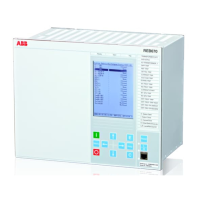Example
Assume two substations A and B directly connected to each other via one line, as
shown in the figure below. W
e study a fault located at another line from the station B.
The fault current to the overcurrent protection of IED B1 has a magnitude so that the
protection will have instantaneous function. The overcurrent protection of IED A1
must have a delayed function. The sequence of events during the fault can be described
using a time axis, see figure
94.
I> I>
A1 B1
Feeder
Time axis
t=0 t=t
2
t=t
3
The fault
occurs
B1 trips and
A1 starts
Breaker at
B1 opens
=IEC05000205=2=en=Original.vsd
Fault
t=t
4
Protection
A1 resets
t=t
1
B1 and A1
start
IEC05000205 V2 EN-US
Figure 94: Sequence of events during fault
where:
t=0 is the fault occurs,
t=t
1
is the trip signal from the overcurrent protection at IED B1 is sent. Operation time of this
protection is t1,
t=t
2
is the circuit breaker at IED B1 opens. The circuit breaker opening time is t2 - t1 and
t=t
3
is the overcurrent protection at IED A1 resets. The protection resetting time is t3 - t2.
To ensure that the overcurrent protection at IED A1, is selective to the overcurrent
protection at IED B1, the minimum time dif
ference must be lar
ger that the time t3.
There are uncertainties in the values of protection operation time, breaker opening time
and protection resetting time. Therefor a safety margin has to be included. With normal
values the needed time difference can be calculated according to equation
35.
Section 7 1MRK 505 370-UUS A
Current protection
196 Busbar protection REB670 2.2 ANSI
Application manual

